K/601/1698: Multi-Agency Working for the Benefit of Young People
VerifiedAdded on 2023/06/18
|8
|2209
|398
Report
AI Summary
This assignment delves into the significance of multi-agency and integrated working in enhancing outcomes for children and young people. It elucidates the importance of collaborative efforts in delivering effective services, fostering trust, and promoting a holistic approach to child welfare. The functions of external agencies, common barriers to integrated working (such as poor communication and policy adherence), and referral processes between agencies are discussed. Furthermore, the assignment highlights various communication methods suitable for different situations and emphasizes the critical role of secure information recording, storage, and sharing. It also addresses potential tensions between maintaining confidentiality and disclosing information, particularly in cases of suspected child abuse, highlighting the need for accurate record-keeping and adherence to established procedures. This document provides a comprehensive overview of the principles and practices underpinning effective multi-agency collaboration in safeguarding and promoting the well-being of children and young people.
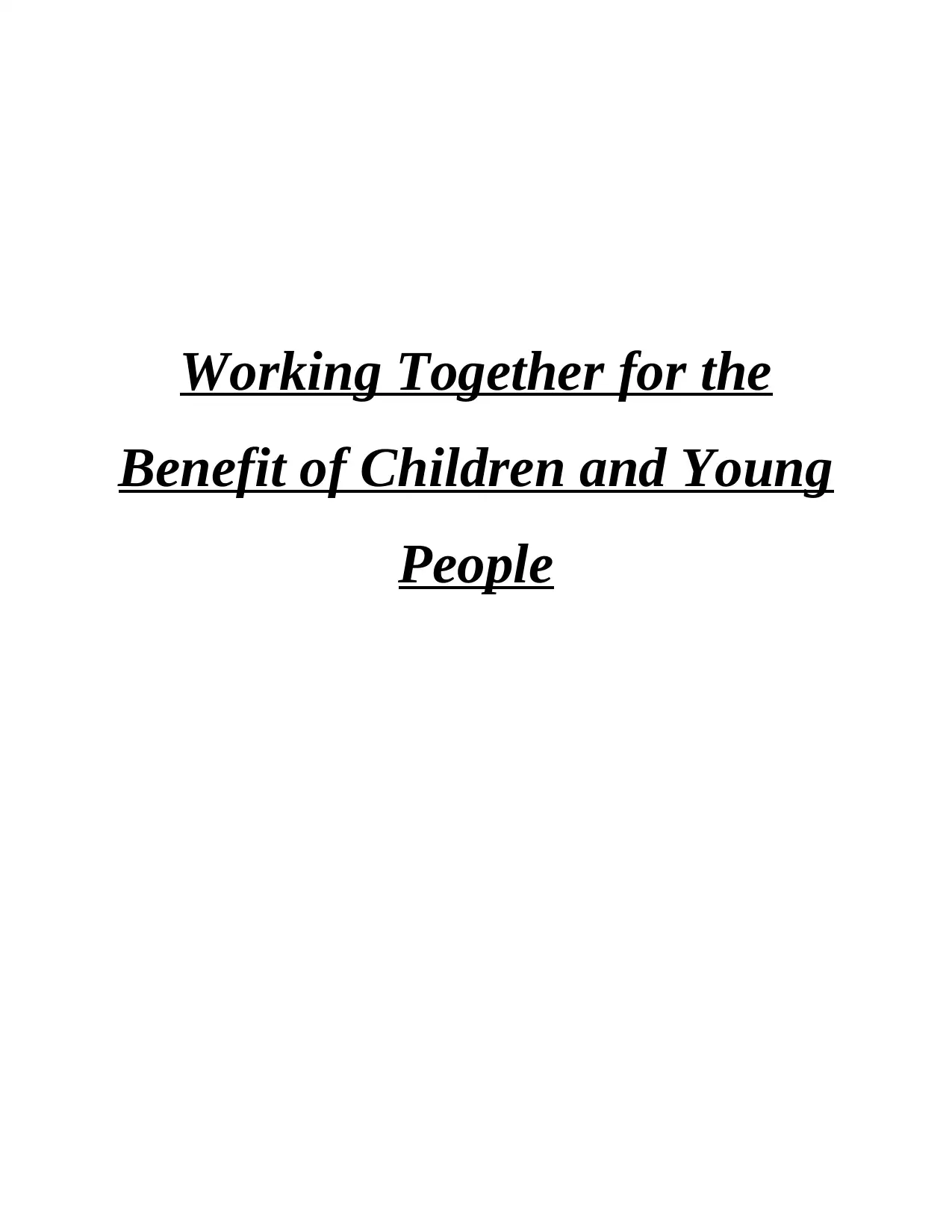
Working Together for the
Benefit of Children and Young
People
Benefit of Children and Young
People
Paraphrase This Document
Need a fresh take? Get an instant paraphrase of this document with our AI Paraphraser
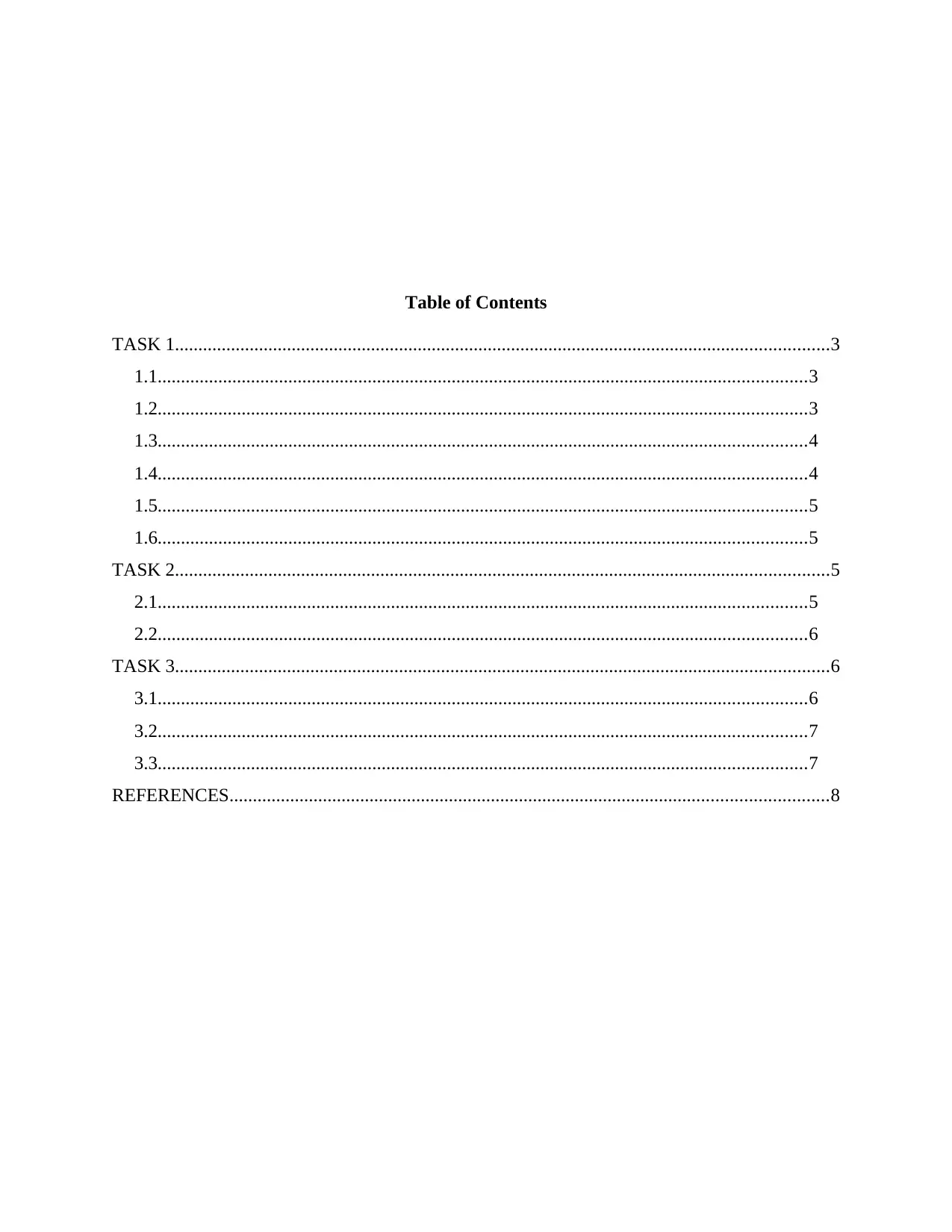
Table of Contents
TASK 1............................................................................................................................................3
1.1...........................................................................................................................................3
1.2...........................................................................................................................................3
1.3...........................................................................................................................................4
1.4...........................................................................................................................................4
1.5...........................................................................................................................................5
1.6...........................................................................................................................................5
TASK 2............................................................................................................................................5
2.1...........................................................................................................................................5
2.2...........................................................................................................................................6
TASK 3............................................................................................................................................6
3.1...........................................................................................................................................6
3.2...........................................................................................................................................7
3.3...........................................................................................................................................7
REFERENCES................................................................................................................................8
TASK 1............................................................................................................................................3
1.1...........................................................................................................................................3
1.2...........................................................................................................................................3
1.3...........................................................................................................................................4
1.4...........................................................................................................................................4
1.5...........................................................................................................................................5
1.6...........................................................................................................................................5
TASK 2............................................................................................................................................5
2.1...........................................................................................................................................5
2.2...........................................................................................................................................6
TASK 3............................................................................................................................................6
3.1...........................................................................................................................................6
3.2...........................................................................................................................................7
3.3...........................................................................................................................................7
REFERENCES................................................................................................................................8
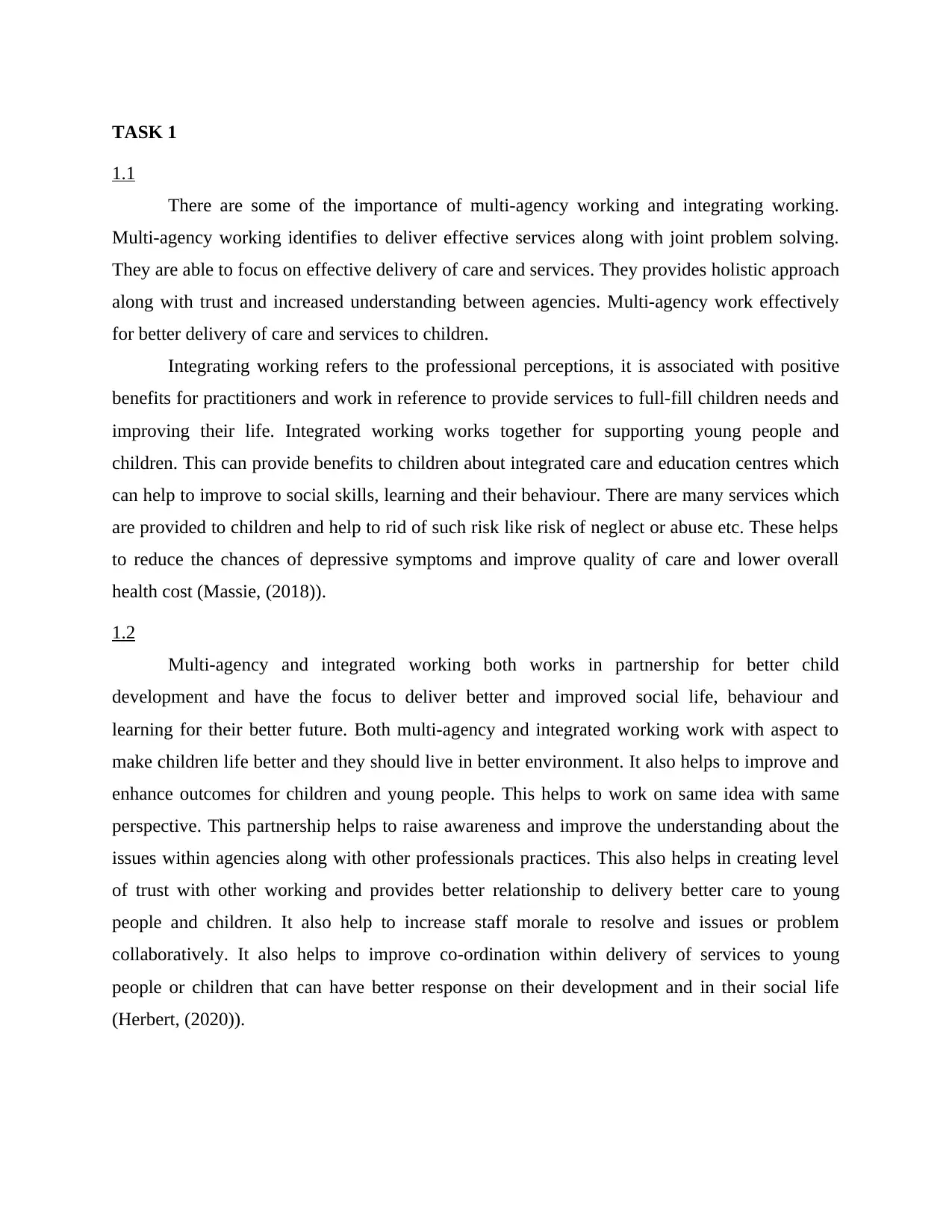
TASK 1
1.1
There are some of the importance of multi-agency working and integrating working.
Multi-agency working identifies to deliver effective services along with joint problem solving.
They are able to focus on effective delivery of care and services. They provides holistic approach
along with trust and increased understanding between agencies. Multi-agency work effectively
for better delivery of care and services to children.
Integrating working refers to the professional perceptions, it is associated with positive
benefits for practitioners and work in reference to provide services to full-fill children needs and
improving their life. Integrated working works together for supporting young people and
children. This can provide benefits to children about integrated care and education centres which
can help to improve to social skills, learning and their behaviour. There are many services which
are provided to children and help to rid of such risk like risk of neglect or abuse etc. These helps
to reduce the chances of depressive symptoms and improve quality of care and lower overall
health cost (Massie, (2018)).
1.2
Multi-agency and integrated working both works in partnership for better child
development and have the focus to deliver better and improved social life, behaviour and
learning for their better future. Both multi-agency and integrated working work with aspect to
make children life better and they should live in better environment. It also helps to improve and
enhance outcomes for children and young people. This helps to work on same idea with same
perspective. This partnership helps to raise awareness and improve the understanding about the
issues within agencies along with other professionals practices. This also helps in creating level
of trust with other working and provides better relationship to delivery better care to young
people and children. It also help to increase staff morale to resolve and issues or problem
collaboratively. It also helps to improve co-ordination within delivery of services to young
people or children that can have better response on their development and in their social life
(Herbert, (2020)).
1.1
There are some of the importance of multi-agency working and integrating working.
Multi-agency working identifies to deliver effective services along with joint problem solving.
They are able to focus on effective delivery of care and services. They provides holistic approach
along with trust and increased understanding between agencies. Multi-agency work effectively
for better delivery of care and services to children.
Integrating working refers to the professional perceptions, it is associated with positive
benefits for practitioners and work in reference to provide services to full-fill children needs and
improving their life. Integrated working works together for supporting young people and
children. This can provide benefits to children about integrated care and education centres which
can help to improve to social skills, learning and their behaviour. There are many services which
are provided to children and help to rid of such risk like risk of neglect or abuse etc. These helps
to reduce the chances of depressive symptoms and improve quality of care and lower overall
health cost (Massie, (2018)).
1.2
Multi-agency and integrated working both works in partnership for better child
development and have the focus to deliver better and improved social life, behaviour and
learning for their better future. Both multi-agency and integrated working work with aspect to
make children life better and they should live in better environment. It also helps to improve and
enhance outcomes for children and young people. This helps to work on same idea with same
perspective. This partnership helps to raise awareness and improve the understanding about the
issues within agencies along with other professionals practices. This also helps in creating level
of trust with other working and provides better relationship to delivery better care to young
people and children. It also help to increase staff morale to resolve and issues or problem
collaboratively. It also helps to improve co-ordination within delivery of services to young
people or children that can have better response on their development and in their social life
(Herbert, (2020)).
⊘ This is a preview!⊘
Do you want full access?
Subscribe today to unlock all pages.

Trusted by 1+ million students worldwide
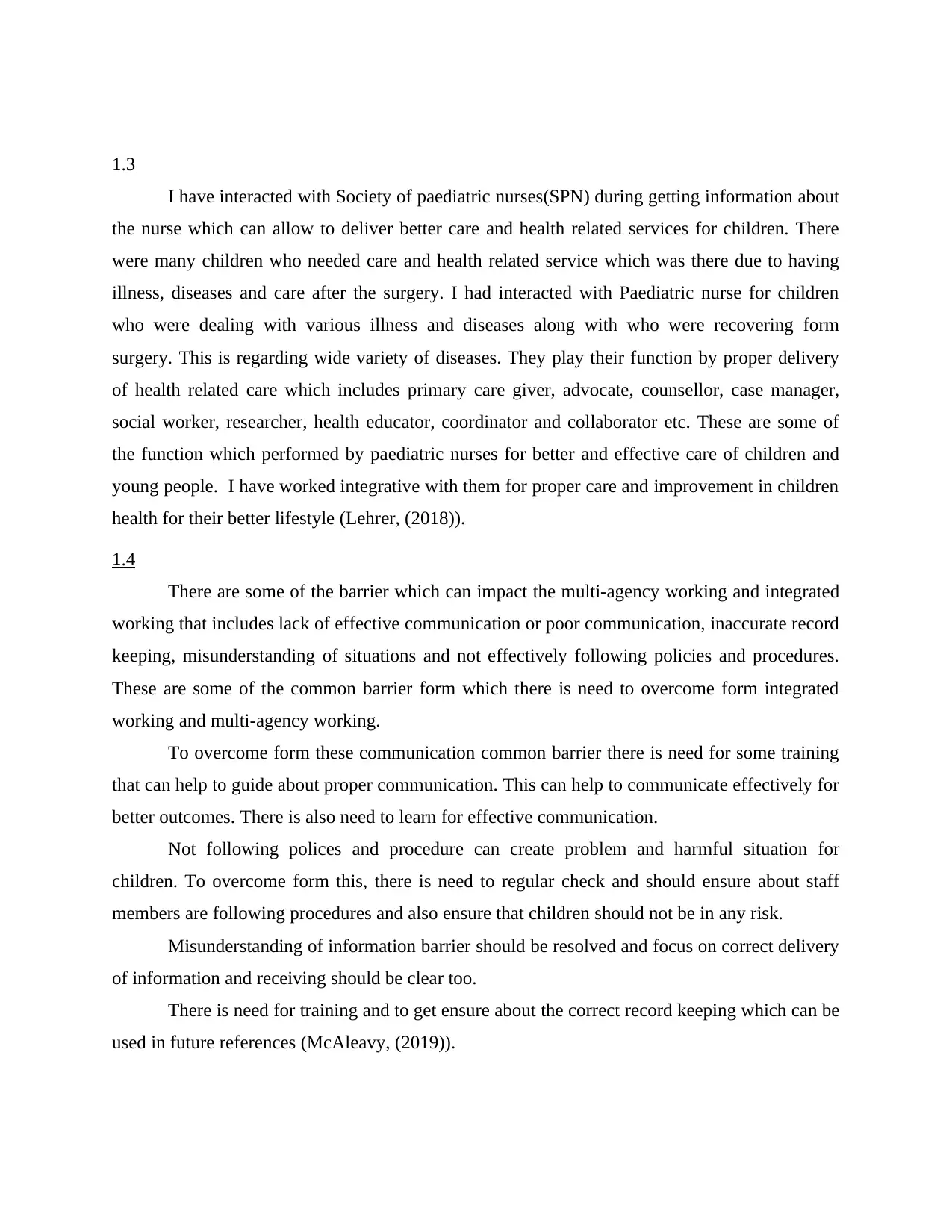
1.3
I have interacted with Society of paediatric nurses(SPN) during getting information about
the nurse which can allow to deliver better care and health related services for children. There
were many children who needed care and health related service which was there due to having
illness, diseases and care after the surgery. I had interacted with Paediatric nurse for children
who were dealing with various illness and diseases along with who were recovering form
surgery. This is regarding wide variety of diseases. They play their function by proper delivery
of health related care which includes primary care giver, advocate, counsellor, case manager,
social worker, researcher, health educator, coordinator and collaborator etc. These are some of
the function which performed by paediatric nurses for better and effective care of children and
young people. I have worked integrative with them for proper care and improvement in children
health for their better lifestyle (Lehrer, (2018)).
1.4
There are some of the barrier which can impact the multi-agency working and integrated
working that includes lack of effective communication or poor communication, inaccurate record
keeping, misunderstanding of situations and not effectively following policies and procedures.
These are some of the common barrier form which there is need to overcome form integrated
working and multi-agency working.
To overcome form these communication common barrier there is need for some training
that can help to guide about proper communication. This can help to communicate effectively for
better outcomes. There is also need to learn for effective communication.
Not following polices and procedure can create problem and harmful situation for
children. To overcome form this, there is need to regular check and should ensure about staff
members are following procedures and also ensure that children should not be in any risk.
Misunderstanding of information barrier should be resolved and focus on correct delivery
of information and receiving should be clear too.
There is need for training and to get ensure about the correct record keeping which can be
used in future references (McAleavy, (2019)).
I have interacted with Society of paediatric nurses(SPN) during getting information about
the nurse which can allow to deliver better care and health related services for children. There
were many children who needed care and health related service which was there due to having
illness, diseases and care after the surgery. I had interacted with Paediatric nurse for children
who were dealing with various illness and diseases along with who were recovering form
surgery. This is regarding wide variety of diseases. They play their function by proper delivery
of health related care which includes primary care giver, advocate, counsellor, case manager,
social worker, researcher, health educator, coordinator and collaborator etc. These are some of
the function which performed by paediatric nurses for better and effective care of children and
young people. I have worked integrative with them for proper care and improvement in children
health for their better lifestyle (Lehrer, (2018)).
1.4
There are some of the barrier which can impact the multi-agency working and integrated
working that includes lack of effective communication or poor communication, inaccurate record
keeping, misunderstanding of situations and not effectively following policies and procedures.
These are some of the common barrier form which there is need to overcome form integrated
working and multi-agency working.
To overcome form these communication common barrier there is need for some training
that can help to guide about proper communication. This can help to communicate effectively for
better outcomes. There is also need to learn for effective communication.
Not following polices and procedure can create problem and harmful situation for
children. To overcome form this, there is need to regular check and should ensure about staff
members are following procedures and also ensure that children should not be in any risk.
Misunderstanding of information barrier should be resolved and focus on correct delivery
of information and receiving should be clear too.
There is need for training and to get ensure about the correct record keeping which can be
used in future references (McAleavy, (2019)).
Paraphrase This Document
Need a fresh take? Get an instant paraphrase of this document with our AI Paraphraser
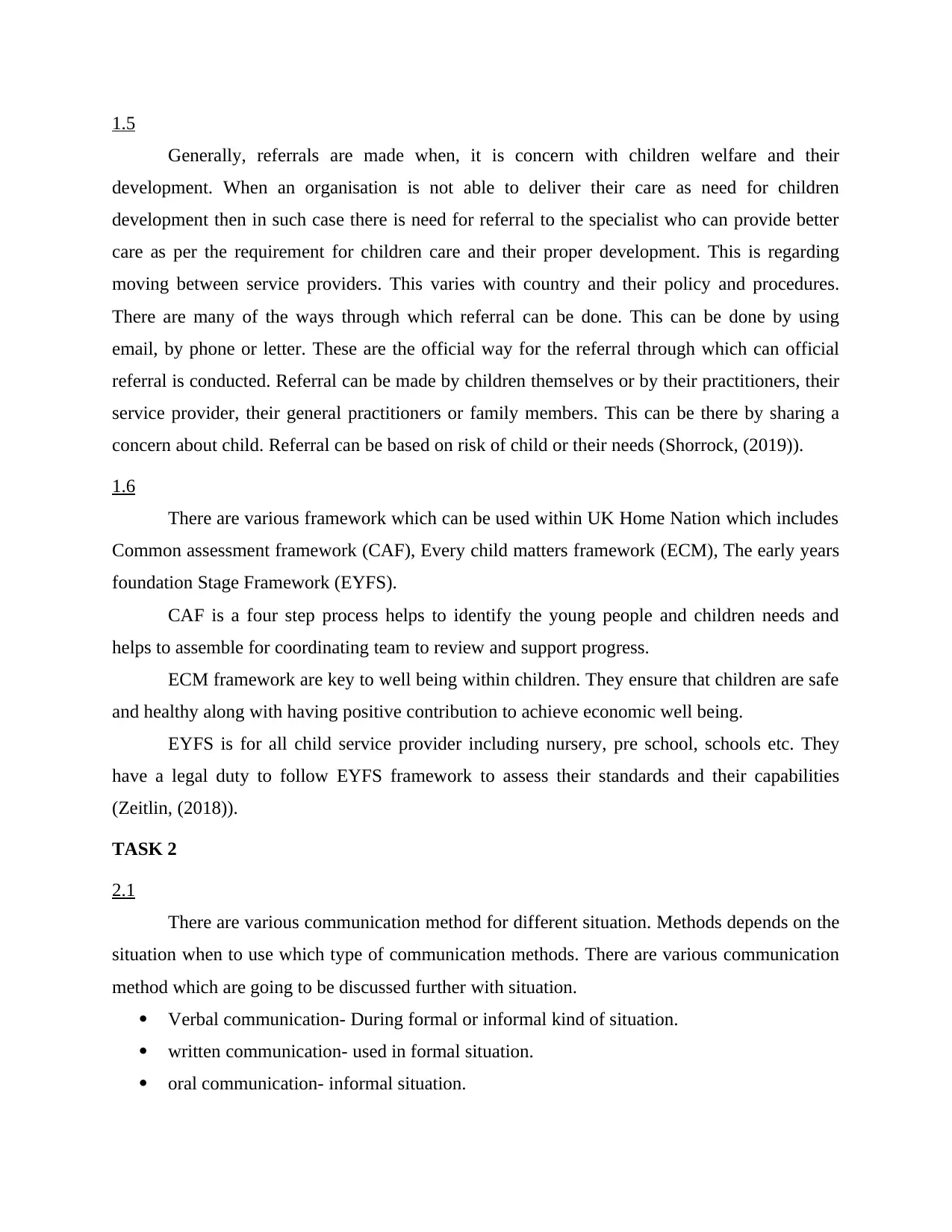
1.5
Generally, referrals are made when, it is concern with children welfare and their
development. When an organisation is not able to deliver their care as need for children
development then in such case there is need for referral to the specialist who can provide better
care as per the requirement for children care and their proper development. This is regarding
moving between service providers. This varies with country and their policy and procedures.
There are many of the ways through which referral can be done. This can be done by using
email, by phone or letter. These are the official way for the referral through which can official
referral is conducted. Referral can be made by children themselves or by their practitioners, their
service provider, their general practitioners or family members. This can be there by sharing a
concern about child. Referral can be based on risk of child or their needs (Shorrock, (2019)).
1.6
There are various framework which can be used within UK Home Nation which includes
Common assessment framework (CAF), Every child matters framework (ECM), The early years
foundation Stage Framework (EYFS).
CAF is a four step process helps to identify the young people and children needs and
helps to assemble for coordinating team to review and support progress.
ECM framework are key to well being within children. They ensure that children are safe
and healthy along with having positive contribution to achieve economic well being.
EYFS is for all child service provider including nursery, pre school, schools etc. They
have a legal duty to follow EYFS framework to assess their standards and their capabilities
(Zeitlin, (2018)).
TASK 2
2.1
There are various communication method for different situation. Methods depends on the
situation when to use which type of communication methods. There are various communication
method which are going to be discussed further with situation.
Verbal communication- During formal or informal kind of situation.
written communication- used in formal situation.
oral communication- informal situation.
Generally, referrals are made when, it is concern with children welfare and their
development. When an organisation is not able to deliver their care as need for children
development then in such case there is need for referral to the specialist who can provide better
care as per the requirement for children care and their proper development. This is regarding
moving between service providers. This varies with country and their policy and procedures.
There are many of the ways through which referral can be done. This can be done by using
email, by phone or letter. These are the official way for the referral through which can official
referral is conducted. Referral can be made by children themselves or by their practitioners, their
service provider, their general practitioners or family members. This can be there by sharing a
concern about child. Referral can be based on risk of child or their needs (Shorrock, (2019)).
1.6
There are various framework which can be used within UK Home Nation which includes
Common assessment framework (CAF), Every child matters framework (ECM), The early years
foundation Stage Framework (EYFS).
CAF is a four step process helps to identify the young people and children needs and
helps to assemble for coordinating team to review and support progress.
ECM framework are key to well being within children. They ensure that children are safe
and healthy along with having positive contribution to achieve economic well being.
EYFS is for all child service provider including nursery, pre school, schools etc. They
have a legal duty to follow EYFS framework to assess their standards and their capabilities
(Zeitlin, (2018)).
TASK 2
2.1
There are various communication method for different situation. Methods depends on the
situation when to use which type of communication methods. There are various communication
method which are going to be discussed further with situation.
Verbal communication- During formal or informal kind of situation.
written communication- used in formal situation.
oral communication- informal situation.
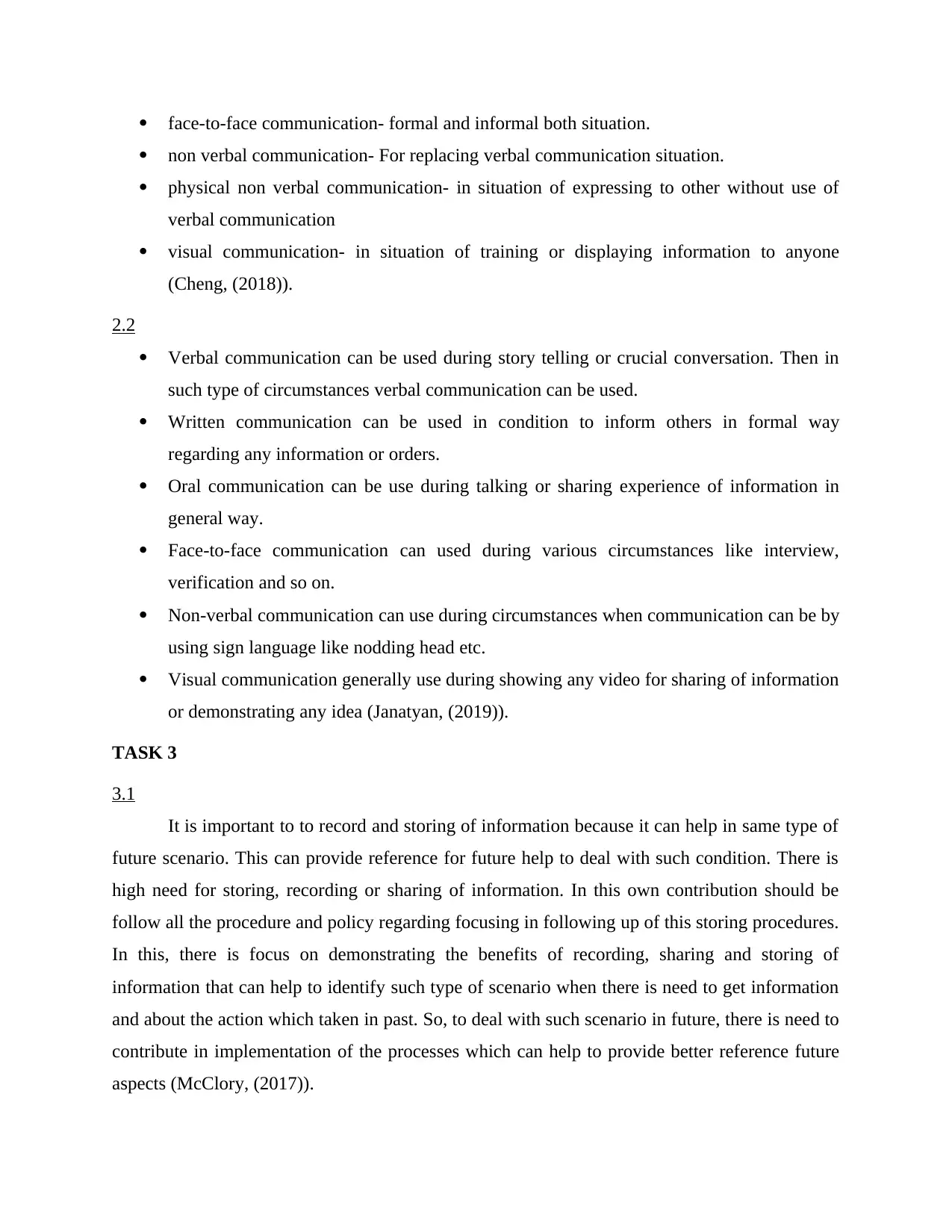
face-to-face communication- formal and informal both situation.
non verbal communication- For replacing verbal communication situation.
physical non verbal communication- in situation of expressing to other without use of
verbal communication
visual communication- in situation of training or displaying information to anyone
(Cheng, (2018)).
2.2
Verbal communication can be used during story telling or crucial conversation. Then in
such type of circumstances verbal communication can be used.
Written communication can be used in condition to inform others in formal way
regarding any information or orders.
Oral communication can be use during talking or sharing experience of information in
general way.
Face-to-face communication can used during various circumstances like interview,
verification and so on.
Non-verbal communication can use during circumstances when communication can be by
using sign language like nodding head etc.
Visual communication generally use during showing any video for sharing of information
or demonstrating any idea (Janatyan, (2019)).
TASK 3
3.1
It is important to to record and storing of information because it can help in same type of
future scenario. This can provide reference for future help to deal with such condition. There is
high need for storing, recording or sharing of information. In this own contribution should be
follow all the procedure and policy regarding focusing in following up of this storing procedures.
In this, there is focus on demonstrating the benefits of recording, sharing and storing of
information that can help to identify such type of scenario when there is need to get information
and about the action which taken in past. So, to deal with such scenario in future, there is need to
contribute in implementation of the processes which can help to provide better reference future
aspects (McClory, (2017)).
non verbal communication- For replacing verbal communication situation.
physical non verbal communication- in situation of expressing to other without use of
verbal communication
visual communication- in situation of training or displaying information to anyone
(Cheng, (2018)).
2.2
Verbal communication can be used during story telling or crucial conversation. Then in
such type of circumstances verbal communication can be used.
Written communication can be used in condition to inform others in formal way
regarding any information or orders.
Oral communication can be use during talking or sharing experience of information in
general way.
Face-to-face communication can used during various circumstances like interview,
verification and so on.
Non-verbal communication can use during circumstances when communication can be by
using sign language like nodding head etc.
Visual communication generally use during showing any video for sharing of information
or demonstrating any idea (Janatyan, (2019)).
TASK 3
3.1
It is important to to record and storing of information because it can help in same type of
future scenario. This can provide reference for future help to deal with such condition. There is
high need for storing, recording or sharing of information. In this own contribution should be
follow all the procedure and policy regarding focusing in following up of this storing procedures.
In this, there is focus on demonstrating the benefits of recording, sharing and storing of
information that can help to identify such type of scenario when there is need to get information
and about the action which taken in past. So, to deal with such scenario in future, there is need to
contribute in implementation of the processes which can help to provide better reference future
aspects (McClory, (2017)).
⊘ This is a preview!⊘
Do you want full access?
Subscribe today to unlock all pages.

Trusted by 1+ million students worldwide
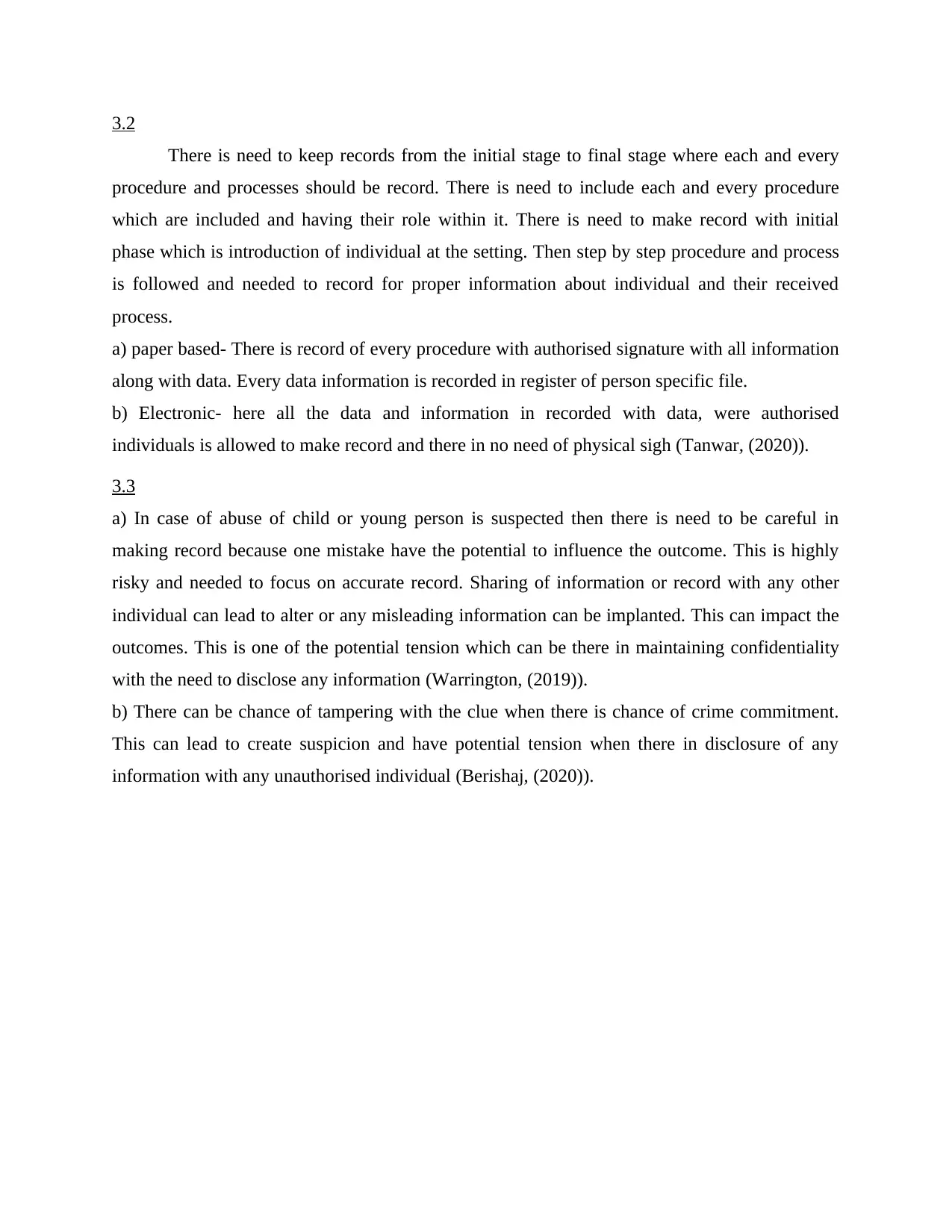
3.2
There is need to keep records from the initial stage to final stage where each and every
procedure and processes should be record. There is need to include each and every procedure
which are included and having their role within it. There is need to make record with initial
phase which is introduction of individual at the setting. Then step by step procedure and process
is followed and needed to record for proper information about individual and their received
process.
a) paper based- There is record of every procedure with authorised signature with all information
along with data. Every data information is recorded in register of person specific file.
b) Electronic- here all the data and information in recorded with data, were authorised
individuals is allowed to make record and there in no need of physical sigh (Tanwar, (2020)).
3.3
a) In case of abuse of child or young person is suspected then there is need to be careful in
making record because one mistake have the potential to influence the outcome. This is highly
risky and needed to focus on accurate record. Sharing of information or record with any other
individual can lead to alter or any misleading information can be implanted. This can impact the
outcomes. This is one of the potential tension which can be there in maintaining confidentiality
with the need to disclose any information (Warrington, (2019)).
b) There can be chance of tampering with the clue when there is chance of crime commitment.
This can lead to create suspicion and have potential tension when there in disclosure of any
information with any unauthorised individual (Berishaj, (2020)).
There is need to keep records from the initial stage to final stage where each and every
procedure and processes should be record. There is need to include each and every procedure
which are included and having their role within it. There is need to make record with initial
phase which is introduction of individual at the setting. Then step by step procedure and process
is followed and needed to record for proper information about individual and their received
process.
a) paper based- There is record of every procedure with authorised signature with all information
along with data. Every data information is recorded in register of person specific file.
b) Electronic- here all the data and information in recorded with data, were authorised
individuals is allowed to make record and there in no need of physical sigh (Tanwar, (2020)).
3.3
a) In case of abuse of child or young person is suspected then there is need to be careful in
making record because one mistake have the potential to influence the outcome. This is highly
risky and needed to focus on accurate record. Sharing of information or record with any other
individual can lead to alter or any misleading information can be implanted. This can impact the
outcomes. This is one of the potential tension which can be there in maintaining confidentiality
with the need to disclose any information (Warrington, (2019)).
b) There can be chance of tampering with the clue when there is chance of crime commitment.
This can lead to create suspicion and have potential tension when there in disclosure of any
information with any unauthorised individual (Berishaj, (2020)).
Paraphrase This Document
Need a fresh take? Get an instant paraphrase of this document with our AI Paraphraser
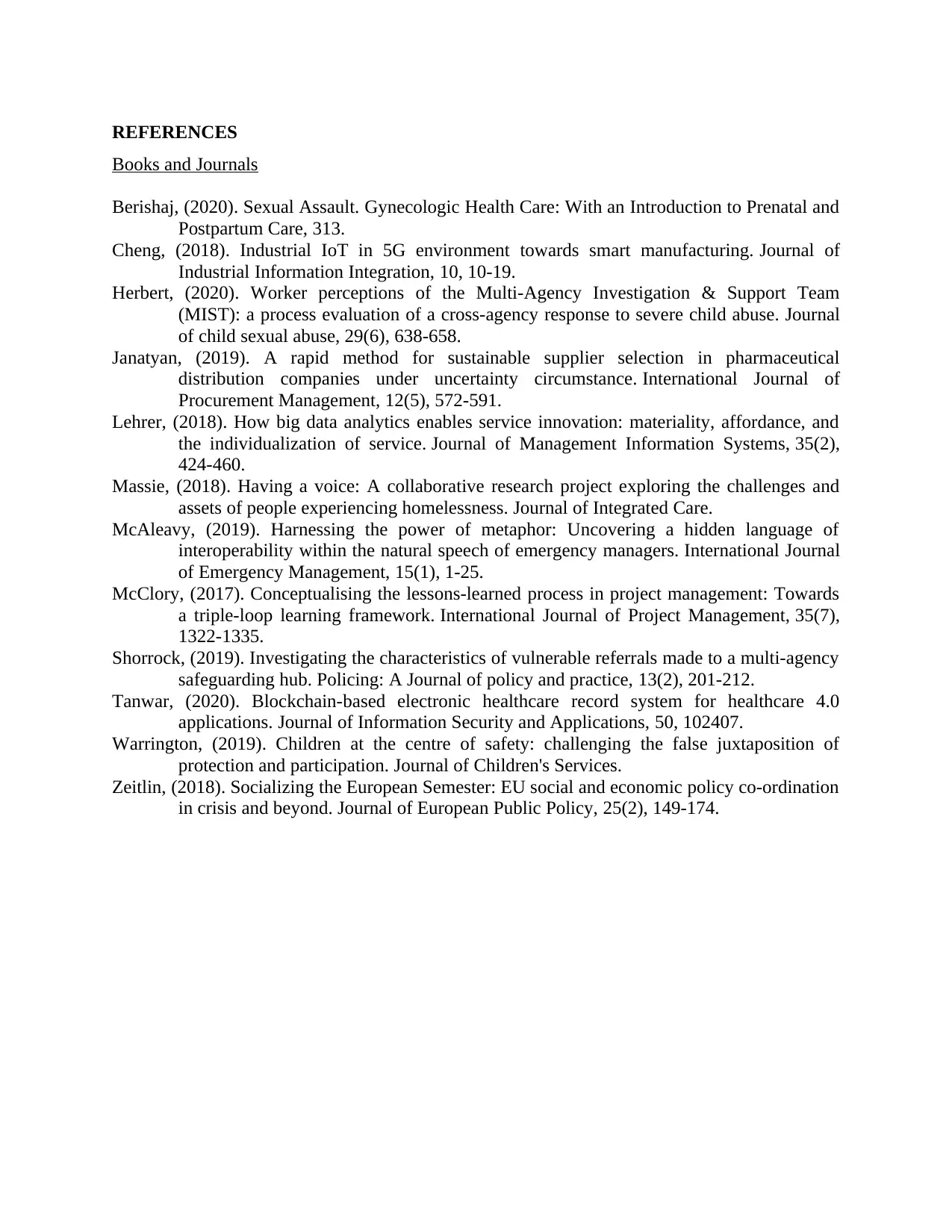
REFERENCES
Books and Journals
Berishaj, (2020). Sexual Assault. Gynecologic Health Care: With an Introduction to Prenatal and
Postpartum Care, 313.
Cheng, (2018). Industrial IoT in 5G environment towards smart manufacturing. Journal of
Industrial Information Integration, 10, 10-19.
Herbert, (2020). Worker perceptions of the Multi-Agency Investigation & Support Team
(MIST): a process evaluation of a cross-agency response to severe child abuse. Journal
of child sexual abuse, 29(6), 638-658.
Janatyan, (2019). A rapid method for sustainable supplier selection in pharmaceutical
distribution companies under uncertainty circumstance. International Journal of
Procurement Management, 12(5), 572-591.
Lehrer, (2018). How big data analytics enables service innovation: materiality, affordance, and
the individualization of service. Journal of Management Information Systems, 35(2),
424-460.
Massie, (2018). Having a voice: A collaborative research project exploring the challenges and
assets of people experiencing homelessness. Journal of Integrated Care.
McAleavy, (2019). Harnessing the power of metaphor: Uncovering a hidden language of
interoperability within the natural speech of emergency managers. International Journal
of Emergency Management, 15(1), 1-25.
McClory, (2017). Conceptualising the lessons-learned process in project management: Towards
a triple-loop learning framework. International Journal of Project Management, 35(7),
1322-1335.
Shorrock, (2019). Investigating the characteristics of vulnerable referrals made to a multi-agency
safeguarding hub. Policing: A Journal of policy and practice, 13(2), 201-212.
Tanwar, (2020). Blockchain-based electronic healthcare record system for healthcare 4.0
applications. Journal of Information Security and Applications, 50, 102407.
Warrington, (2019). Children at the centre of safety: challenging the false juxtaposition of
protection and participation. Journal of Children's Services.
Zeitlin, (2018). Socializing the European Semester: EU social and economic policy co-ordination
in crisis and beyond. Journal of European Public Policy, 25(2), 149-174.
Books and Journals
Berishaj, (2020). Sexual Assault. Gynecologic Health Care: With an Introduction to Prenatal and
Postpartum Care, 313.
Cheng, (2018). Industrial IoT in 5G environment towards smart manufacturing. Journal of
Industrial Information Integration, 10, 10-19.
Herbert, (2020). Worker perceptions of the Multi-Agency Investigation & Support Team
(MIST): a process evaluation of a cross-agency response to severe child abuse. Journal
of child sexual abuse, 29(6), 638-658.
Janatyan, (2019). A rapid method for sustainable supplier selection in pharmaceutical
distribution companies under uncertainty circumstance. International Journal of
Procurement Management, 12(5), 572-591.
Lehrer, (2018). How big data analytics enables service innovation: materiality, affordance, and
the individualization of service. Journal of Management Information Systems, 35(2),
424-460.
Massie, (2018). Having a voice: A collaborative research project exploring the challenges and
assets of people experiencing homelessness. Journal of Integrated Care.
McAleavy, (2019). Harnessing the power of metaphor: Uncovering a hidden language of
interoperability within the natural speech of emergency managers. International Journal
of Emergency Management, 15(1), 1-25.
McClory, (2017). Conceptualising the lessons-learned process in project management: Towards
a triple-loop learning framework. International Journal of Project Management, 35(7),
1322-1335.
Shorrock, (2019). Investigating the characteristics of vulnerable referrals made to a multi-agency
safeguarding hub. Policing: A Journal of policy and practice, 13(2), 201-212.
Tanwar, (2020). Blockchain-based electronic healthcare record system for healthcare 4.0
applications. Journal of Information Security and Applications, 50, 102407.
Warrington, (2019). Children at the centre of safety: challenging the false juxtaposition of
protection and participation. Journal of Children's Services.
Zeitlin, (2018). Socializing the European Semester: EU social and economic policy co-ordination
in crisis and beyond. Journal of European Public Policy, 25(2), 149-174.
1 out of 8
Related Documents
Your All-in-One AI-Powered Toolkit for Academic Success.
+13062052269
info@desklib.com
Available 24*7 on WhatsApp / Email
![[object Object]](/_next/static/media/star-bottom.7253800d.svg)
Unlock your academic potential
Copyright © 2020–2025 A2Z Services. All Rights Reserved. Developed and managed by ZUCOL.



